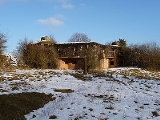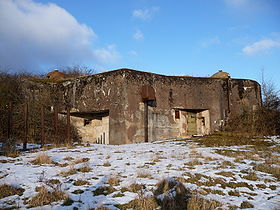
Ouvrage Lembach
Encyclopedia
Ouvrage Lembach is a petit ouvrage of the Maginot Line
. Lembach is adjoined by petit ouvrage Grand Hohekirkel
at some distance to its west and gros ouvrage Four-à-Chaux immediately to its east. It faces the German
frontier, and was part of the Fortified Sector of the Vosges
. During the Battle of France
in 1940, the German 215th Infantry Division broke through the line of smaller fortifications to the west of Lembach, but did not directly attack. After aerial bombardments, Lembach surrendered with the rest of the Maginot fortifications according to the terms of the Second Armistice at Compiègne. After the war Lembach was renovated for further use, but was abandoned by the 1970s.
s and infantry shelters are in the vicinity of Lembach, including
Additionally, the space between Lembach and Grand-Hohékirkel , its neighbor to the west, is filled by more than forty casemates and blockhouses along the river Schwartzbach and across the ridge to the Sauer river
.

. The German advance continued into the Vosges region, but did not directly attack Lembach. Lembach, Four-à-Chaux and Hochwald formally surrendered on 1 July 1940.
, where most action took place around Hochwald and Schoenenbourg
.
. Lembach was repaired and put in a state of readiness in 1951-52. By the late 1950s interest in fixed fortifications was waning after France developed a nuclear deterrent. The money needed to maintain and upgrade the fortifications was diverted for the nuclear programs. Lembach was not manned or maintained after the early 1970s
Maginot Line
The Maginot Line , named after the French Minister of War André Maginot, was a line of concrete fortifications, tank obstacles, artillery casemates, machine gun posts, and other defences, which France constructed along its borders with Germany and Italy, in light of its experience in World War I,...
. Lembach is adjoined by petit ouvrage Grand Hohekirkel
Ouvrage Grand Hohekirkel
Ouvrage Grand-Hohékirkel is a petit ouvrage of the Maginot Line, located near Bitche in the French département of Moselle. Grand-Hohékirkel is adjoined by gros ouvrage Otterbiel to the west and petit ouvrage Lembach at some distance to the east, and faces the German frontier...
at some distance to its west and gros ouvrage Four-à-Chaux immediately to its east. It faces the German
Germany
Germany , officially the Federal Republic of Germany , is a federal parliamentary republic in Europe. The country consists of 16 states while the capital and largest city is Berlin. Germany covers an area of 357,021 km2 and has a largely temperate seasonal climate...
frontier, and was part of the Fortified Sector of the Vosges
Fortified Sector of the Vosges
The Fortified Sector of the Vosges was the French military organization that in 1940 controlled the section of the Maginot Line at the northern end of the Vosges Mountains in northeastern France. The sector was bordered to the west by the Fortified Sector of Rohrbach and to the east by the...
. During the Battle of France
Battle of France
In the Second World War, the Battle of France was the German invasion of France and the Low Countries, beginning on 10 May 1940, which ended the Phoney War. The battle consisted of two main operations. In the first, Fall Gelb , German armoured units pushed through the Ardennes, to cut off and...
in 1940, the German 215th Infantry Division broke through the line of smaller fortifications to the west of Lembach, but did not directly attack. After aerial bombardments, Lembach surrendered with the rest of the Maginot fortifications according to the terms of the Second Armistice at Compiègne. After the war Lembach was renovated for further use, but was abandoned by the 1970s.
Design and construction
The site was surveyed by CORF (Commission d'Organisation des Régions Fortifiées), the Maginot Line's design and construction agency; Lembach was approved for construction in July 1931. The petit ouvrage was to be expanded in a second phase of construction, planned but not carried out, envisioned the addition of an 81mm mortar turret and new, separate munitions and personnelentries.Description
Lembach comprises an entry block, two infantry blocks and one observation block. A small entry block exists near Block 1, with underground barracks and service areas along the gallery that links the combat blocks.- Block 1: Infantry block with two GFM cloches, one twin machine gun clocheJM clocheThe JM cloche is an element of the Maginot Line. It is a non-retractable non-rotating cupola of steel alloy like GFM cloches, but are armed with twin heavy machine guns, as opposed to the lighter automatic rifles associated with the GFM. There are 179 JM cloches on the Maginot Line.JM is an acronym...
and one machine gun (JM)/47mm anti-tank gunAC 47 anti-tank gunThe AC 47 was a French anti-tank gun of 47mm caliber. It was principally used in the ouvrages and casemates of the Maginot Line in the late 1930s; another version was created for naval use....
embrasure (JM/AC47). - Block 2: Infantry block with two GFM cloches, one twin machine gun clocheJM clocheThe JM cloche is an element of the Maginot Line. It is a non-retractable non-rotating cupola of steel alloy like GFM cloches, but are armed with twin heavy machine guns, as opposed to the lighter automatic rifles associated with the GFM. There are 179 JM cloches on the Maginot Line.JM is an acronym...
and one machine gun (JM)/47mm anti-tank gunAC 47 anti-tank gunThe AC 47 was a French anti-tank gun of 47mm caliber. It was principally used in the ouvrages and casemates of the Maginot Line in the late 1930s; another version was created for naval use....
embrasure (JM/AC47). - Block 3: Infantry block with one GFM cloche, two twin machine gun clochesJM clocheThe JM cloche is an element of the Maginot Line. It is a non-retractable non-rotating cupola of steel alloy like GFM cloches, but are armed with twin heavy machine guns, as opposed to the lighter automatic rifles associated with the GFM. There are 179 JM cloches on the Maginot Line.JM is an acronym...
and one observation colche (VDP)VDP clocheThe VDP cloche was an element of the Maginot Line fortifications. A cloche was a fixed and non-retractable firing position made of a thick iron casting which shielded its occupant. By comparison, turrets could be rotated and sometimes lowered so that only the top shell was exposed. VDP cloches...
. - Entry: Entry block with two automatic rifle embrasures.
Casemates and shelters
A series of detached casemateCasemate
A casemate, sometimes rendered casement, is a fortified gun emplacement or armored structure from which guns are fired. originally a vaulted chamber in a fortress.-Origin of the term:...
s and infantry shelters are in the vicinity of Lembach, including
- Casemate de Lembach: Casemate in close proximity to Lembach's entrance, but not connected. Single block with one JM/AC47 embrasure, one twin machine gun embrasure and a GFM cloche.
Additionally, the space between Lembach and Grand-Hohékirkel , its neighbor to the west, is filled by more than forty casemates and blockhouses along the river Schwartzbach and across the ridge to the Sauer river
Sauer
The Sauer or Sûre is a river in Belgium, Luxembourg and Germany. A left tributary of the river Moselle, its total length is 173 km....
.
Manning
The 1940 manning of the ouvrage under the command of Captain Drouin comprised 58 men and 4 officers of the 165th Fortress Infantry Regiment. The units were under the umbrella of the 5th Army. The nearby Casernement de Lembach provided peacetime above-ground barracks and support services to Lembach and other positions in the area.History

- See Fortified Sector of the VosgesFortified Sector of the VosgesThe Fortified Sector of the Vosges was the French military organization that in 1940 controlled the section of the Maginot Line at the northern end of the Vosges Mountains in northeastern France. The sector was bordered to the west by the Fortified Sector of Rohrbach and to the east by the...
for a broader discussion of the Vosges sector of the Maginot Line.
1940
On 19 June 1940, the German 215th Infantry Division attacked in the area immediately to the west of Lembach, between the river Schwartzbach and Lembach. Later in the day, Lembach and other ouvrages were bombed by Stukas with no significant effect. The next day an attack was repelled with artillery support from HochwaldOuvrage Hochwald
Ouvrage Hochwald is a gros ouvrage of the Maginot Line, one of the largest fortifications in the Line. Located in the Fortified Sector of Haguenau in the community of Drachenbronn-Birlenbach in the Bas-Rhin department of northeastern France, it was designed to protect the northern Vosges region of...
. The German advance continued into the Vosges region, but did not directly attack Lembach. Lembach, Four-à-Chaux and Hochwald formally surrendered on 1 July 1940.
1944-1945
Lembach saw little action during the Lorraine CampaignLorraine Campaign
Lorraine Campaign is a term used by U.S. Army historians to describe operations of the U.S. Third Army in Lorraine during World War II from September 1 through December 18, 1944. Official U.S. Army campaign names for this period and location are Northern France and Rhineland. The term was...
, where most action took place around Hochwald and Schoenenbourg
Ouvrage Schoenenbourg
Ouvrage Schoenenbourg is a Maginot Line fortification. It is located on the territory of the communes of Hunspach, Schœnenbourg and Ingolsheim, in the French département of Bas-Rhin, forming part of the Fortified Sector of Haguenau, facing Germany. At the east end of the Alsace portion of the...
.
Cold War
In the 1950s interest in the Maginot Line was renewed. In 1951, Lembach, Four-à-Chaux, Hochwald and Schoenenbourg were designated the Môle de Haguenau, a point of resistance against a potential invasion by forces of the Warsaw PactWarsaw Pact
The Warsaw Treaty Organization of Friendship, Cooperation, and Mutual Assistance , or more commonly referred to as the Warsaw Pact, was a mutual defense treaty subscribed to by eight communist states in Eastern Europe...
. Lembach was repaired and put in a state of readiness in 1951-52. By the late 1950s interest in fixed fortifications was waning after France developed a nuclear deterrent. The money needed to maintain and upgrade the fortifications was diverted for the nuclear programs. Lembach was not manned or maintained after the early 1970s
See also
- List of all works on Maginot Line
- Siegfried LineSiegfried LineThe original Siegfried line was a line of defensive forts and tank defences built by Germany as a section of the Hindenburg Line 1916–1917 in northern France during World War I...
- Atlantic WallAtlantic WallThe Atlantic Wall was an extensive system of coastal fortifications built by Nazi Germany between 1942 and 1944 along the western coast of Europe as a defense against an anticipated Allied invasion of the mainland continent from Great Britain.-History:On March 23, 1942 Führer Directive Number 40...
- Czechoslovak border fortificationsCzechoslovak border fortificationsThe Czechoslovak government built a system of border fortifications from 1935 to 1938 as a defensive countermeasure against the rising threat of Nazi Germany that later materialized in the German offensive plan called Fall Grün...

